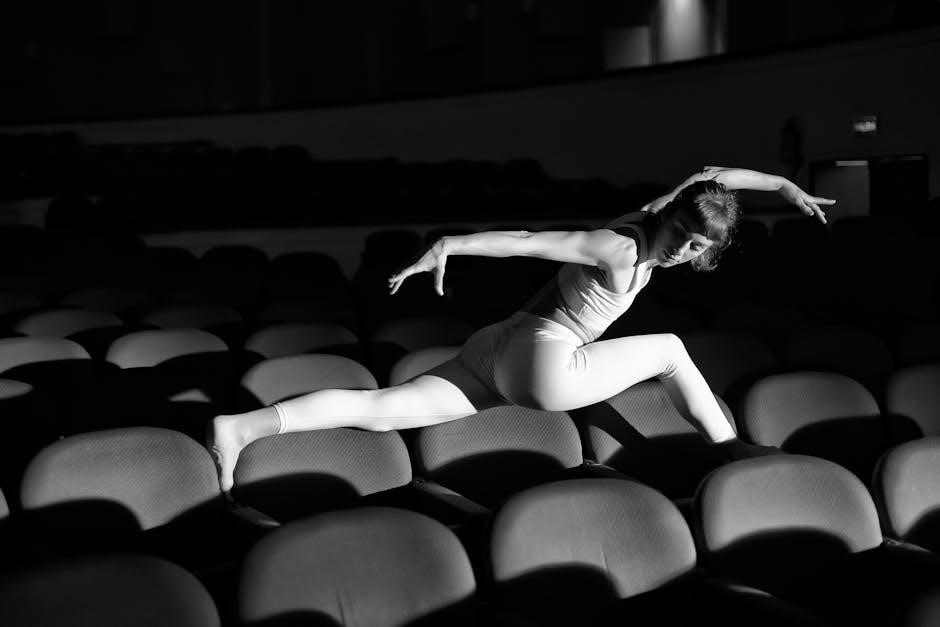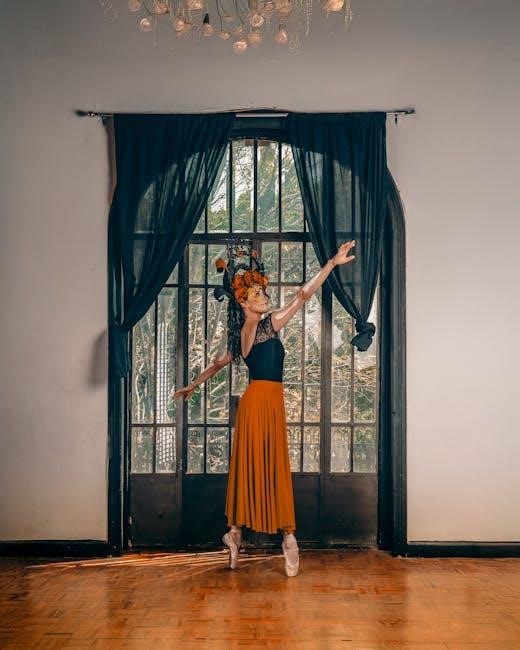Welcome to the world of ballet, where precise terminology is essential for mastering techniques. Ballet terms, often French or Italian, form the foundation of communication in dance. Understanding these words helps dancers execute movements accurately. With visual guides like PDFs, learners can see poses and steps, making mastery easier. This section introduces key ballet terms, providing a clear starting point for beginners.
1.1 Importance of Understanding Ballet Terminology
Understanding ballet terminology is crucial for clear communication and proper execution of movements. Each term, often in French or Italian, describes precise techniques, ensuring accuracy and safety. Without this knowledge, dancers may misinterpret instructions, leading to incorrect movements and potential injuries. Visual guides, like PDFs with pictures, enhance comprehension, making complex terms more accessible for learners of all levels.
1.2 Brief History of Ballet Terms
Ballet terminology traces its roots to Italy and France, where the art form evolved. Many terms remain in French or Italian, reflecting its historical origins. Over centuries, these terms have been refined to describe precise movements and techniques. Visual guides, such as PDFs with images, have become invaluable tools for learners, helping to clarify and preserve this rich linguistic and technical heritage of ballet.

Basic Ballet Positions
Ballet begins with fundamental positions that establish proper alignment and turnout. These include positions of the feet, arms, and body, such as first, second, third, fourth, and fifth positions. Visual guides like PDFs provide clear images, helping dancers master these essential poses and transitions with precision and grace.
2.1 Positions of the Feet
The five basic positions of the feet are fundamental to ballet technique. Each position requires precise turnout and alignment, with heels together and toes turned out. Visual guides, such as those in PDFs, illustrate these positions clearly, aiding dancers in achieving proper form. Mastery of these foot positions is essential for executing movements correctly and safely, forming the cornerstone of ballet training.
2.2 Positions of the Arms
In ballet, arm positions are crucial for maintaining proper alignment and expression. The five basic arm positions, known as “port de bras,” include bras bas (low), first, second, third, fourth, and fifth positions. These positions require grace and control, with hands softly curved. Visual guides, such as those in PDFs, help dancers master these poses, ensuring fluid transitions and elegant lines in their movements.

Ballet Movements and Techniques
Ballet movements blend grace and precision, with techniques like allegro (fast) and adagio (slow) forming the core. Visual guides, such as PDFs, help dancers master these techniques effectively.
3.1 Allegro Movements
Allegro movements are fast and dynamic, requiring precision and energy. Techniques include jumps and leaps, executed with quick footwork. Visual guides, such as PDFs, provide detailed illustrations, helping dancers master these intricate steps. These resources often include step-by-step instructions and images, ensuring proper alignment and execution. Allegro is fundamental for building strength and agility in ballet training.
3.2 Adagio Movements
Adagio movements are slow and controlled, emphasizing balance and grace. Dancers perform long, flowing poses to showcase strength and artistry. PDF guides provide detailed images and instructions, highlighting proper alignment and transitions. These resources help dancers develop the precision and fluidity essential for adagio sequences, fostering a deeper understanding of ballet’s expressive qualities.

Ballet Jumps and Leaps
Ballet jumps and leaps are dynamic movements that showcase a dancer’s strength and agility. From petit allegro to grand allegro, these techniques require precision and control. PDF guides often include visual aids to help dancers master proper execution and timing, ensuring fluidity and grace in performance.
4.1 Types of Jumps
Ballet jumps are categorized into petit and grand allegro. Petit allegro includes quick, small jumps like temps levé, while grand allegro features large, sweeping leaps such as grand jeté. Other types include échappé and tour en l’air. PDF guides often illustrate these jumps with visuals, helping dancers understand proper technique and execution for a polished performance.
4.2 Execution Techniques
Proper execution of ballet jumps requires precise technique. Dancers must maintain proper body alignment, engage core muscles, and ensure smooth transitions. Visual guides in PDFs often highlight key points like foot placement and arm positioning. Mastery of these techniques enhances both performance quality and safety, allowing dancers to execute jumps with control and grace.

Turns in Ballet
TURNS are fundamental in ballet, showcasing grace and control. Visual guides in PDFs illustrate techniques like en dehors and fouetté, aiding dancers in mastering rotations with precision.
5.1 En dehors and En dedans Turns
En dehors turns involve rotating outward, while en dedans turns rotate inward. Both require precise alignment and spotting. Visual guides in PDFs, such as diagrams, help dancers master these techniques by illustrating proper body positioning and rotation direction, ensuring clarity and accuracy in execution.
5.2 Fouetté and Other Advanced Turns
Fouetté is a dynamic turn where one leg whips around while turning, often performed in series. Advanced turns demand precision, control, and strong core engagement. Visual guides in PDFs illustrate proper execution, emphasizing spotting and alignment. These resources help dancers master techniques like fouetté, ensuring clarity and artistry in their performance.

Barre Work in Ballet
Barre work is fundamental in ballet, using a railing for balance. It includes exercises like tendu and battement, essential for technique. PDF guides with visuals provide clear instruction.
6.1 Fundamental Barre Exercises
Fundamental barre exercises include tendu, battement, and plié, essential for building strength and technique. These exercises focus on proper alignment, foot placement, and fluid movement. Visual guides in PDFs demonstrate each step, making it easier for dancers to master these foundational movements. Regular practice at the barre enhances balance, flexibility, and overall ballet proficiency.
6.2 Importance of Barre in Technique Development
The barre is crucial for developing proper ballet technique, providing support and stability. It allows dancers to focus on alignment, turnout, and precise movements. PDF guides with images help illustrate correct form, ensuring dancers master foundational skills before advancing. Regular barre practice strengthens the core and improves balance, laying a solid foundation for more complex movements.

Flexibility and Stretching
Flexibility is crucial for ballet, enabling optimal movement and preventing injuries. PDF guides offer visual stretches to improve range of motion safely and effectively for dancers.
7.1 Essential Stretches for Ballet Dancers
Hamstring, quadriceps, and hip flexor stretches are vital for ballet dancers to maintain flexibility. PDF guides often include detailed illustrations of these stretches, ensuring proper technique and alignment. Regular practice prevents injuries and enhances performance.
7.2 Improving Flexibility Safely
Improving flexibility requires consistent, gentle practice. Dynamic stretches before class and static stretches post-exercise are recommended. PDF guides often illustrate safe techniques, emphasizing proper alignment and breath control. Avoid bouncing to prevent muscle strain. Gradual progression and professional guidance ensure safe advancement, minimizing injury risks while enhancing range of motion effectively.

Types of Ballet
Ballet encompasses various styles, including classical and modern. Classical ballet emphasizes traditional techniques, while modern ballet incorporates contemporary movements, offering diverse expressions for dancers and audiences alike.
8.1 Classical Ballet
Classical ballet is the foundation of traditional ballet, emphasizing precise techniques and graceful movements. Originating in Italy and refined in France, it showcases symmetrical poses, pointe work, and structured choreography. Dancers adhere to strict alignment and turnout, with movements often telling a story. Visual guides, like PDFs, help illustrate proper form and execution, making it easier for learners to master classical techniques effectively.
8.2 Modern and Contemporary Ballet
Modern and contemporary ballet evolved from classical techniques, embracing expression and creativity. Dancers use fluid movements, often breaking traditional rules, to convey emotion. Contemporary ballet incorporates diverse influences, such as modern and jazz, creating dynamic performances. Visual guides, like PDFs, showcase these evolving techniques, helping dancers understand the blend of tradition and innovation in modern ballet practices.
Pointe Work in Ballet
Pointe work involves dancing on the tips of the toes using specially designed shoes. It requires strength, proper technique, and rigorous training. Visual guides, such as PDFs, provide detailed illustrations and instructions, helping dancers master pointe techniques safely and effectively. They often include step-by-step tutorials and images to ensure correct alignment and execution.
9.1 Preparing for Pointe Shoes
Preparing for pointe shoes requires building strength, proper alignment, and mastery of basic techniques. Dancers must develop sufficient arch and ankle support. PDF guides often include exercises and visual aids to help achieve the necessary readiness. Professional fitting ensures proper shoe fit, crucial for safety and performance. Visual instructions in PDFs aid in understanding the process and maintaining correct form.
9.2 Basic Pointe Techniques
Basic pointe techniques include proper alignment, weight distribution, and controlled movements. Dancers must master bourrées, échappés, and arabesque poses. Visual guides in PDFs demonstrate these steps, emphasizing toe placement and turnout. Strengthening exercises and proper shoe fit are crucial for executing techniques safely and effectively. These foundational skills build the confidence and precision needed for advanced pointe work.

Arm and Hand Movements
Arm and hand movements in ballet, such as port de bras, emphasize grace and expression. Proper positioning and fluid transitions are key to conveying emotion through dance.
10.1 Port de Bras Techniques
Port de bras involves moving the arms seamlessly through various positions, emphasizing fluidity and control. Proper alignment and muscle engagement are crucial for achieving graceful transitions. Visual guides, such as those in PDF resources, provide detailed illustrations of each arm position, helping dancers master the technique. Practice and consistency are key to perfecting this fundamental aspect of ballet.
10.2 Expressive Use of Hands
In ballet, hands are vital for expression, conveying emotion beyond technical movements. Proper placement and movement of the hands enhance storytelling and artistry. Visual guides, such as those in PDF resources, illustrate how hands should be positioned to evoke grace and drama. Mastery of hand techniques allows dancers to connect with audiences on a deeper level, making their performances more engaging and meaningful.
The Five Basic Positions
Ballet’s foundation lies in five basic positions, each refining alignment and posture. These positions, illustrated in PDF guides, help dancers achieve proper technique and transitions seamlessly.
11.1 First to Fifth Positions Explained
The five basic ballet positions establish foundational alignment. First position: heels together, toes turned out. Second: feet apart, toes out. Third: one foot in front, heel to arch. Fourth: feet crossed, heels apart. Fifth: feet tightly crossed. Visual guides in PDFs, like diagrams, help dancers master these poses, ensuring proper technique and alignment from the start.
11.2 Transitioning Between Positions
Smooth transitions between ballet positions require precision and control. Visual guides in PDFs often illustrate these movements, showing how to shift weight and align the body seamlessly. Practices like pliés and tendus help connect positions fluidly. Proper alignment and movement quality are emphasized, ensuring dancers maintain technique while transitioning. These visual aids make mastering the flow between positions more accessible for learners.
Ballet Terminology with Visual Guides
Visual guides, such as PDFs, enhance understanding of ballet terms by providing clear images and step-by-step instructions. They help learners grasp complex movements and techniques effectively.
12.1 Benefits of Visual Learning
Visual learning enhances ballet education by providing clear, step-by-step guides. PDF resources with images and diagrams allow dancers to see proper techniques, improving understanding and execution. This method aids in mastering complex movements and alignment, making learning more effective and engaging for ballet enthusiasts of all levels. Visual aids bridge the gap between theory and practice seamlessly.
12.2 Recommended PDF Resources
Several PDF guides offer comprehensive insights into ballet terminology. A Ballet Terms with Pictures PDF provides detailed explanations of movements like tendu and arabesque, complete with visual demonstrations. Additionally, resources such as BalletDancersGuide and Ballet Grade 5 PDFs include glossaries and step-by-step instructions, making them invaluable tools for dancers seeking to master ballet techniques effectively.
Body Alignment and Posture
Proper body alignment and posture are crucial in ballet, ensuring balance and technique. Common mistakes include rounded shoulders and misaligned hips. Visual guides in PDFs help correct these issues, promoting graceful and injury-free dancing by maintaining the correct skeletal and muscular positioning throughout movements.
13.1 Correct Posture in Ballet
Correct posture in ballet requires a straight spine, engaged core, and relaxed shoulders. The head should be held high, with ears aligned over shoulders. Visual guides in PDFs demonstrate proper alignment, ensuring dancers maintain optimal positioning. This foundational posture enhances balance, prevents injuries, and allows for precise execution of movements. Proper alignment also improves overall aesthetic and technique in performances.
13.2 Common Alignment Mistakes
Common alignment mistakes in ballet include hunched shoulders, misaligned hips, and improper weight distribution. Dancers often tilt their heads or torsos incorrectly, affecting balance. These errors can strain muscles and hinder technique. Visual guides in PDFs highlight proper alignment, helping dancers correct these issues and maintain optimal posture for safe and effective movement execution.
Resources for Learning Ballet Terms
Discover comprehensive PDF guides and online tutorials offering detailed ballet terminology with visual aids. These resources provide clear explanations and images, enhancing understanding of ballet techniques and terms effectively.
14.1 PDF Guides and Manuals
PDF guides and manuals are excellent resources for learning ballet terms, offering detailed explanations and visuals. These documents often include step-by-step instructions, images, and diagrams to illustrate proper techniques. Many PDFs are available online, providing accessible and organized information for dancers. They cover essential terms, movements, and exercises, making them invaluable for both beginners and advanced learners seeking to refine their understanding of ballet terminology.
14.2 Online Tutorials and Videos
Online tutorials and videos complement PDF guides by providing live demonstrations of ballet techniques. Platforms like YouTube and specialized dance websites offer step-by-step lessons, allowing dancers to observe and mimic movements. Video resources often include breakdowns of complex terms and exercises, making them ideal for visual learners. They enhance understanding by showing real-time execution and proper form, aiding in mastery of ballet terminology and techniques.

Common Ballet Injuries and Prevention
Ballet injuries often result from overuse or improper technique, such as shin splints and ankle sprains. Proper warm-ups, stretching, and correct alignments help prevent these issues. Using supportive footwear and strengthening exercises can also reduce injury risks, ensuring dancers maintain optimal health and performance.
15.1 Injuries Related to Overuse
Overuse injuries in ballet, such as shin splints, ankle sprains, and tendonitis, often arise from repetitive stress on muscles and joints. Dancers may experience stress fractures or Achilles tendon strain due to excessive training without adequate rest. Proper warm-ups, stretching, and footwear can help prevent these issues, ensuring long-term health and performance.
15;2 Prevention Techniques
Preventing ballet injuries involves proper warm-ups, stretching, and strengthening exercises. Wearing supportive footwear and using correct technique are crucial. Cross-training and adequate rest can reduce overuse risks. Mental preparation and professional guidance also play key roles in maintaining dancer health and preventing injuries.
Mastering ballet terms is essential for every dancer. With resources like PDF guides, learning becomes visually engaging. Continuous practice and understanding will enhance your ballet journey and appreciation of this beautiful art form.
16.1 Summary of Key Ballet Terms
Ballet terms form the backbone of dance communication. From tendu to arabesque, understanding these movements is crucial. Visual guides like PDFs provide clear illustrations, aiding dancers in mastering techniques. Terms such as adagio (slow tempo) and allegro (fast) define pacing, while port de bras and turn-out emphasize proper alignment. These resources ensure dancers grasp both terminology and execution effectively.
16.2 Encouragement for Further Study
Mastering ballet terms is a lifelong journey, and further study will deepen your understanding and technique. Explore resources like ballet terms with pictures PDF for visual learning, which complements textual explanations. Practicing regularly and consulting instructional materials will enhance your skills and appreciation for ballet. Embrace curiosity and dedication to unlock the full beauty of this art form.